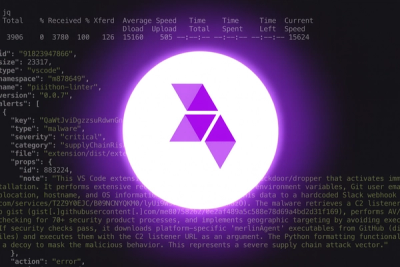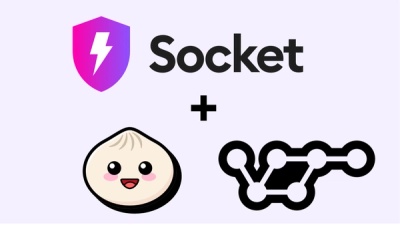
Product
Introducing Socket Scanning for OpenVSX Extensions
Socket now scans OpenVSX extensions, giving teams early detection of risky behaviors, hidden capabilities, and supply chain threats in developer tools.
@ifanrx/faas
Advanced tools
:::tip 如果你已经了解了《必知必会 —— 服务请求 - createIO》》的内容,就可以跳过这部分。 :::

import {createIO} from '@ifanrx/faas'
const io = createIO({
// 知晓云数据表配置
table: {
// key 将作为该表在 io 中的引用名字,value 为该表在知晓云内表名
userprofile: '_userprofile',
settings: 'settings',
likesLog: 'likes_log',
},
/**
* 后端接口配置
* api 若不配置 method,默认会使用 GET 发送请求
* 通过 io.api.apiKey 调用
*/
api: {
getUserprofile: {
method: 'POST',
url: '/xxx',
},
},
/**
* 云函数配置
* 通过 io.faas.faasKey 调用
*/
faas: {
helloWorld: 'hello_world',
},
})
export default io
// 构建知晓云 table 查询条件
// 更多可参考:https://doc.minapp.com/js-sdk/schema/frag/query.html
const query = io.query
query.compare('key', '=', 'something')
// 构建知晓云用户实例
// 更多可参考:https://doc.minapp.com/js-sdk/user.html
const user = io.user
user.get(userID)
// 构建知晓云文件实例
// 更多可参考:https://doc.minapp.com/js-sdk/file/
const file = io.file
file.upload()
// 构建知晓云 table 实例
// 更多可参考:https://doc.minapp.com/js-sdk/schema/
const table = new wx.BaaS.TableObject('_userprofile')
const record = table.create() // 本地创建一条空记录
// 上传单个文件到知晓云
const uploadTask = io.uploadFile(file, options)
uploadTask.onProgressUpdate(e => {
// https://doc.minapp.com/js-sdk/file/file.html#监听上传进度变化事件和中断上传任务-仅限微信小程序
console.log(e)
})
// 上传多个文件到知晓云
const uploadTask = io.uploadFiles(files, options)
// 根据 record id 获取对应记录
io.userprofile.get({id: 'xxx'})
// 根据查找条件找到记录列表
io.userprofile.find({query: io.query, limit: 20, offset: 0})
// 根据查找条件找到第一条满足条件的记录
io.userprofile.first({query: io.query})
// 已知记录 id,修改数据记录
io.userprofile.update({id: 'xxx', data: {name: 'xxx'}})
// 根据查找条件修改记录列表
io.userprofile.updateMany({query: io.query, data: {name: 'xxx'}})
// 已知记录 id,删除记录
io.userprofile.delete({id: 'xxx'})
// 根据查找条件删除记录列表
io.userprofile.deleteMany({query: io.query})
// 创建单条记录
io.userprofile.create({name: 'xxx'})
// 创建多条记录
io.userprofile.createMany([{name: '张三'}, {name: '李四'}])
// 获取满足当前查找条件的记录数量
io.userprofile.count({query: io.query})
// 获取当前数据表内所有数据项
io.userprofile.findAll()
get/find/first/update/updateMany/create 都拥有 plain 参数,当 plain 为 true 时,会将响应数据格式化,返回 response.data(find 操作是个另外,当 plain 为 true 时会返回 response.data.objects),当 plain 为 false 时,则会将完整的 response 返回。plain 默认值都是 true
云函数的调用是对知晓云 sdk 的 BaaS.invoke 进行封装,省略了调用 invoke 时对 functionName 参数的传入,让云函数的调用更加便捷,同时支持代码提示
此处云函数调用的封装对云函数的响应内容进行简单处理,当云函数响应的 code 为 0 时(此时云函数执行成功),会只返回云函数响应结构中的 data 字段,否则会抛出 IOError
faas: {
[P in keyof T]: <
TRequestPayload extends RequestPayload = RequestPayload,
TSync extends boolean = true
>(
payload?: TRequestPayload,
sync?: TSync
) => IOPromise<CloudFunctionResponse<TSync>>
}
const io = createIO({
faas: {
helloWorld: 'hello_world',
},
})
// 默认使用同步的形式调用云函数
io.faas.helloWorld({message: 'hello world'})
// 使用异步的形式调用云函数
io.faas.helloWorld({message: 'hello world'}, false).then(console.log) // {status: 'ok'}
一般来说,在微信小程序内请求后端接口都需要依赖知晓云 sdk 的 BaaS.request,使用用户在知晓云登录获取的 token 来完成鉴权
对后端接口请求的封装主要是省去在调用接口时传入请求 url 和 method 步骤,支持与云函数一致的调用方式,同样支持代码提示
需要注意的是,在调用 createIO 配置 api 时,需要传入该请求对应的 request method,不传默认使用 GET 请求。并且只能用来处理内部的 api,内部 api 有统一的响应结构
{
status: string // 取值有 ok | error
error_code: integer, // 错误状态码
error_msg: string // 底层的错误信息
display_error_msg: string // 前端显示的错误信息
data: {} // 正常数据
}
当 status 为 error 时,抛出 IOError,否则返回 data
declare type ApiMethod =
| 'GET'
| 'OPTIONS'
| 'HEAD'
| 'POST'
| 'PUT'
| 'DELETE'
| 'TRACE'
| 'CONNECT'
declare interface ApiConfig {
method?: ApiMethod
url: string
}
declare type Api = Record<string, ApiConfig>
declare interface ApiRequestOptions {
header?: object
dataType?: string
}
declare interface ApiOperation<T extends Api> {
api: {
[P in keyof T]: (
payload?: RequestPayload,
options?: ApiRequestOptions
) => IOPromise<ApiResponse>
}
}
const io = createIO({
api: {
getUserprofile: {
method: 'POST',
url: '/xxxx',
},
},
})
io.api.getUserprofile({message: 'hello world'}, {header: {xxx: 'xxx'}})
io 内所有方法执行出错时,都会抛出 IOError,方便统一错误处理以及错误上报
class IOError extends Error {
code: number
displayMessage: string
info: Record<string, any>
}
:::tip 通常情况下,小程序端可以配合 message.showIOErrorModal 使用,以便轻松地将错误信息显示给用户。
try {
// 调用 io 方法
} catch (error) {
message.showIOErrorModal(error, {
10001: '优先显示自定义报错',
'request timeout': '网络超时',
default: '当最终文案为空时,使用该默认回退文案',
})
}
:::
FAQs
Unknown package
The npm package @ifanrx/faas receives a total of 2 weekly downloads. As such, @ifanrx/faas popularity was classified as not popular.
We found that @ifanrx/faas demonstrated a healthy version release cadence and project activity because the last version was released less than a year ago. It has 0 open source maintainers collaborating on the project.
Did you know?

Socket for GitHub automatically highlights issues in each pull request and monitors the health of all your open source dependencies. Discover the contents of your packages and block harmful activity before you install or update your dependencies.

Product
Socket now scans OpenVSX extensions, giving teams early detection of risky behaviors, hidden capabilities, and supply chain threats in developer tools.

Product
Bringing supply chain security to the next generation of JavaScript package managers

Product
A safer, faster way to eliminate vulnerabilities without updating dependencies